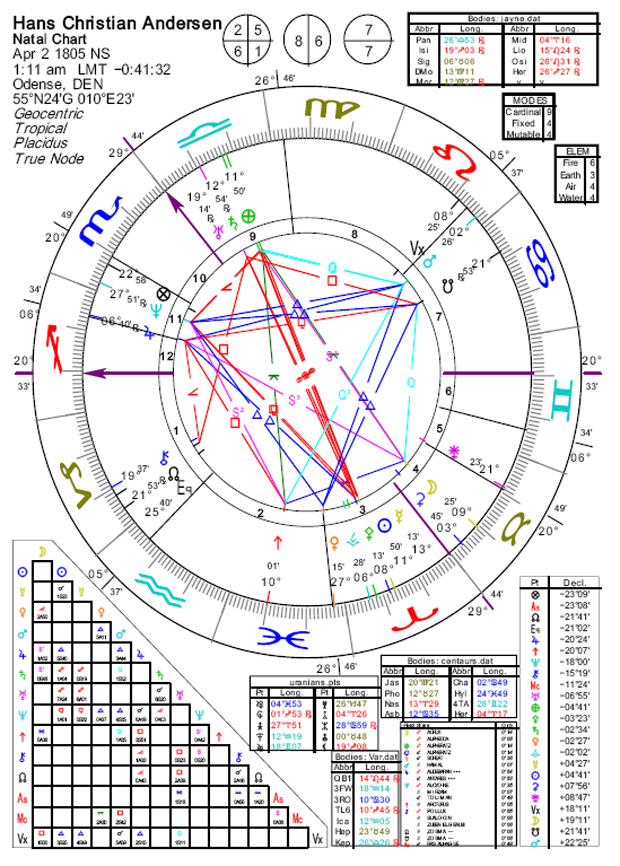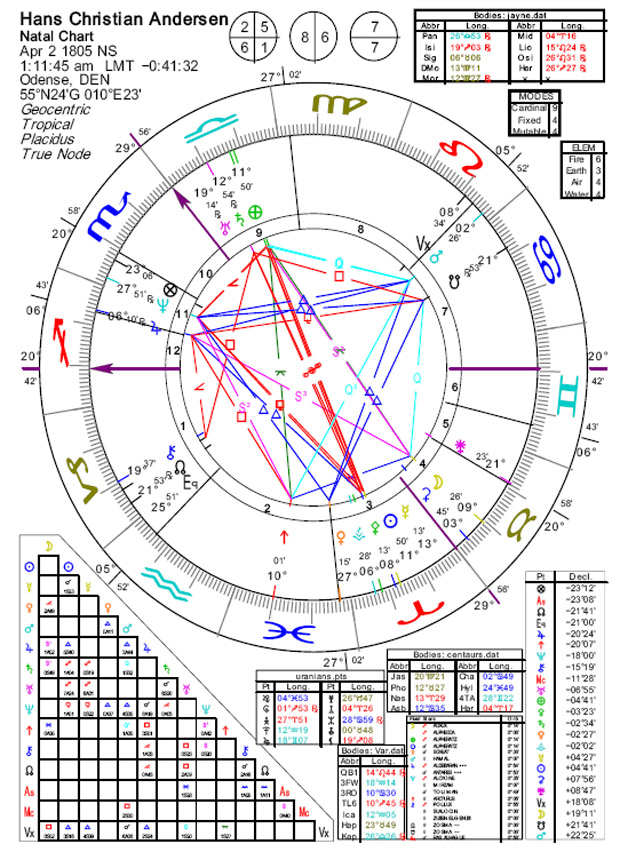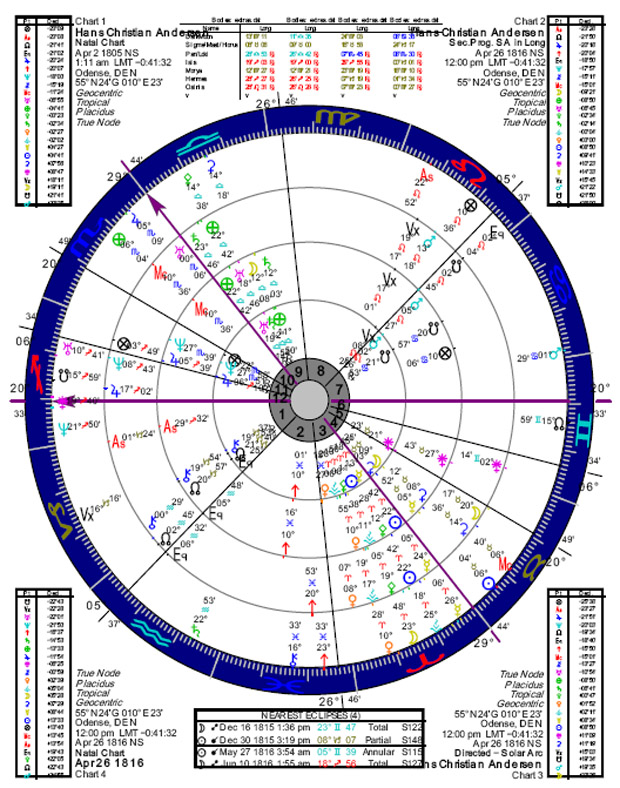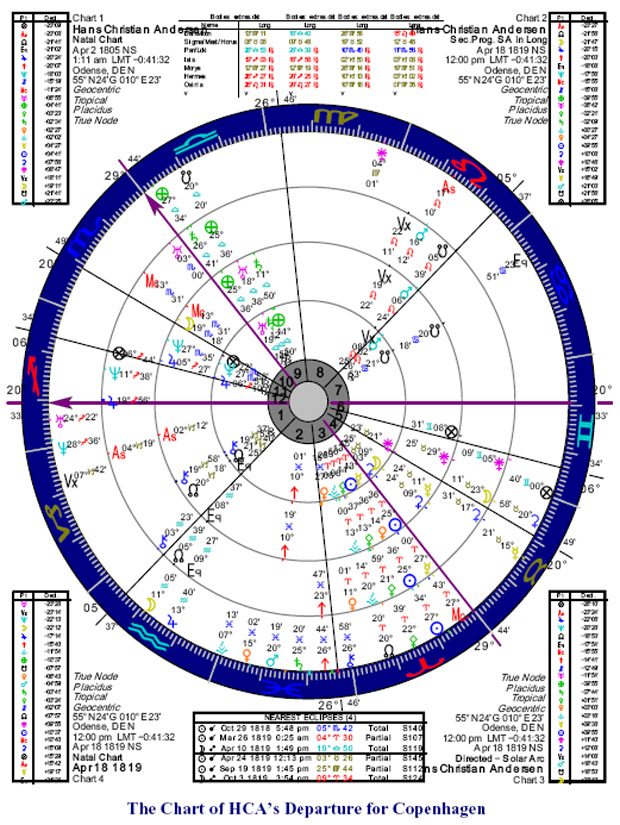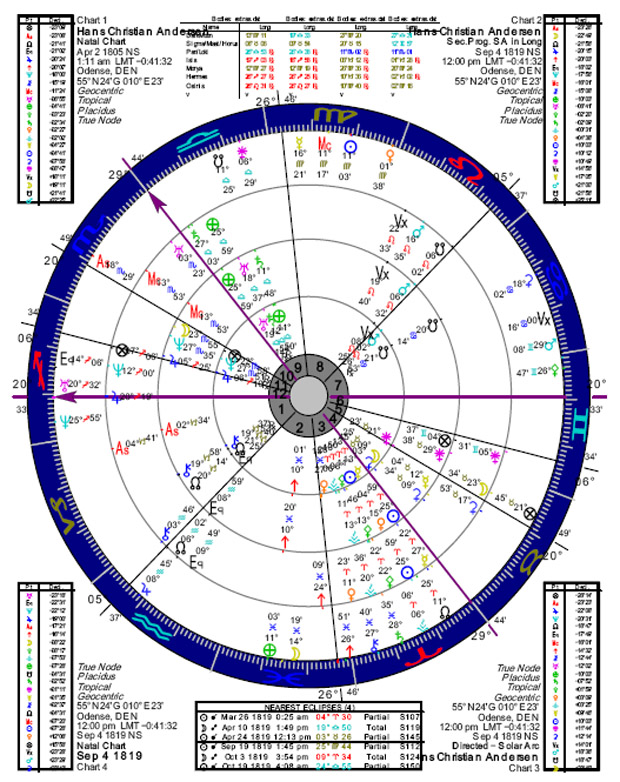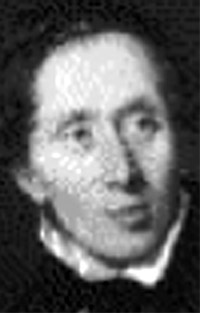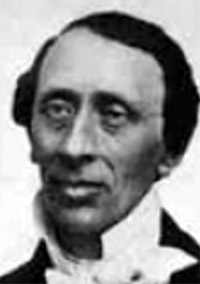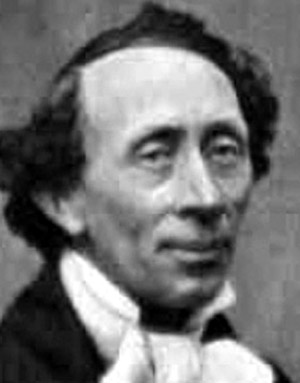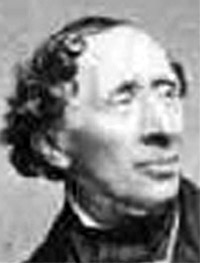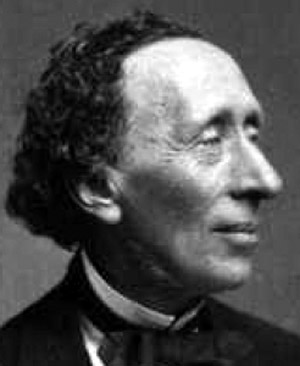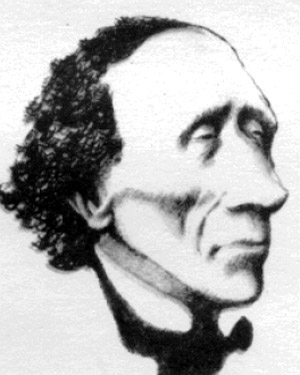Hans Christian Andersen
Copyright Michael D. Robbins 2003
Astro-Rayological Interpretation & Charts
Quotes
Biography
Images and Physiognomic Interpretation
Hans Christian Anderson—Danish Author and Master Story-teller
(1805-1875) April 2, 1805, Odense, Denmark, 1:00 AM, LMT (Source: recorded). Rectified time of approximately 1:11 AM is suggested by the author. Died of cancer, August 4, 1875.
(Ascendant, Sagittarius with Jupiter in Sagittarius, H12; MC in late Libra with Uranus and Saturn conjunct to each other also in Libra; Sun and Mercury in Aries; Moon in Taurus conjunct Ceres; Venus in Pisces; Mars in Leo; Neptune in Scorpio; Pluto in Pisces; Chiron in Capricorn conjunct the North Node)
The Life of Hans Christian Andersen
Hans Christian Anderson was a world-famous Danish author who flourished during the middle nineteenth century. Today he is remembered chiefly for his imaginative, profoundly poignant fairy tale stories which have been translated into more languages than any other books except the Bible. His works have even been translated into Chinese and Japanese and are loved and appreciated by school-children in China and Japan. He had the special knack of turning ideas into tales—in a particularly Nordic, melancholy and, at the same time, witty way. His fairy tales are philosophical, told with amazing narrative joy and sparkling imagination in beautiful, elegant language. Anderson was also a novelist, playwright and writer of numerous widely read travelogues based on his own experience as a traveler. Early in life he aspired to a life in the theatre and auditioned (without success) to become an actor.
Though Hans Christian Andersen was an amazingly successful author, his life, in one sense, was a tale of personal frustration and painful unfulfillment. He was a man filled with love and longing (“my blood is burning”) and yet he never had a single physically intimate relationship with either woman or man.
He became a world-renowned author because he was able to translate the deep pathos of his experience into uniquely narrated stories which touched the hearts of both children and adults. He dared to write in a new idiomatic style, introducing sad and even tragic themes which the authors of his day would have considered inappropriate for children’s books. And yet an enthusiastic response was immediate. People were deeply moved. His sense of fantasy, power of description, and acute sensitivity contributed to his mastery of the fairy tale. His international success and universal recognition compensated in some measure for his personal disappointments in the sphere of relationship, but could not compensate entirely. His life was a fairy tale whose silent, underlying theme was unrequited love.
He was a tall, delicate man with small blue eyes and a large, sharp nose. He was extraordinarily ungainly and many considered him “ugly”. Perhaps, more importantly, he considered himself “ugly”. His arms and legs were disproportionately large for his body and his feet were huge. He attracted nicknames that were descriptive, such as “stork” and “lamp post. One of the most beloved of his fairy stories was “The Ugly Duckling”, growing out of his own rueful self-perceptions and his dreams. In the story the “ugly duckling” is not really ugly at all because the little duckling (so rejected by all the other ducklings) is really a swan—growing into a bird of greater beauty than any mere duckling. Hans Christian Andersen spent most of his life trying to be recognized for the “swan” he longed to be—and which, at heart, he knew he was. It would seem that he was never entirely successful (no matter how great his popularity), though the world has gained immeasurably from the sadness he carried in his heart. Some of Hans Christian Andersen’s most beloved stories are “The Emperor and the Nightingale”, “The Emperor’s New Clothes”, “The Little Match Girl”, “The Red Shoes”, “The Tinder Box”, “Thumbelina” and, of course, “The Ugly Duckling”.The Choice of Astrological Chart a. The usual time of birth given for Hans Christian Andersen is taken from parish records and is, thus, considered a recorded time. Lois Rodden gives it a “AA” rating. The time is 1:00 AM.
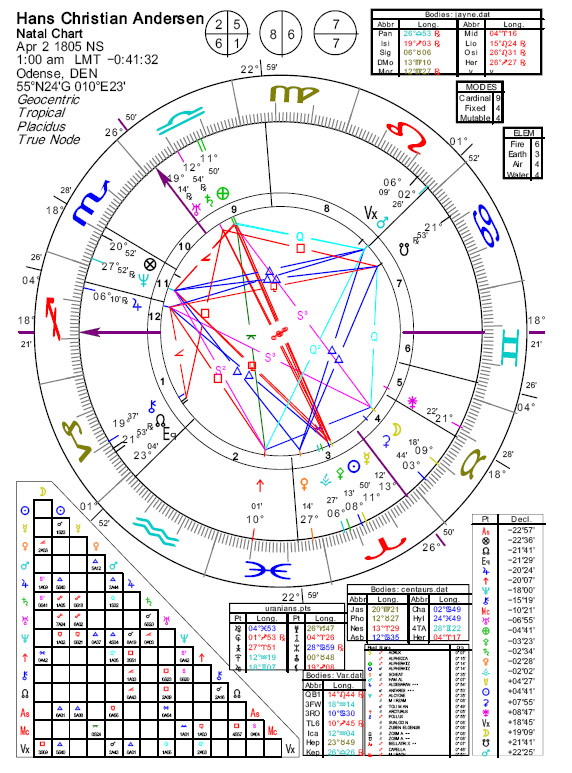
b. One must be suspicious, however, of any time of birth which is given as occurring exactly on the hour. Although some such times must exist (the odds are 1/60), further examination is invited. c. Research into the timing of events in a chart based upon this time demonstrates it to be quite accurate (at least in the estimation of the author). d. The actual time of birth probably occurred somewhere between 1:00 AM and 1:11:45 AM. In those days, birth times were not generally recorded with accuracy, nor written down “to the minute”. It was not the habit and not considered important. The author leans towards a time closer to 1:11 AM and thinks the actual time was between 1:11 AM and 1:11:45 AM, although there are certain instances in which the 1:00 AM chart works very well, and of these the author makes note. e. When such discrepancies between possible times of birth exist, the author feels the best he can do is offer the reader his considered opinion and then expect the reader to decide the issue for himself/herself. f. Whichever time we choose, however, we shall not be far off, and for the purposes of esoteric astrology, we can be assured of having the correct Ascending sign, and Midheaven, if not the correct ascending decanate.
e. The twenty-first degree ascending gives us a strange symbol: “A CHILD AND A DOG WEARING BORROWED EYEGLASSES” “The use of imagination and make-believe in anticipating higher stages of development”. “LEARNING THROUGH IMITATION”. There is something here about the relationship of children and animals. We could say that children learn to see through the eyes of the animal characters found in fairy tales. Rudhyar’s interpretation is quite different, however. a. It seems quite certain that the correct chart for Hans Christian Andersen lies somewhere between 1:00 AM (the time recorded in the Parish document) and 1:11:45. It is difficult to be conclusive about the various charts that can be generated between these times. Sometimes the eclipses tell one story, the transits, another, and the solar arc directions yet another. The number of planets in use is as yet far complete. The ‘mesh of the net’ is still not fine enough. Astrologers are not playing with a “full deck”. Still, we advance by using what we have. b. The time which will be used is 1:11 AM. There are many good indications to be found in this slightly later chart, but at times it fails to look as good as even the 1:00 AM Chart. A few of the discrepancies will be noted. While it may be impossible to arrive at complete lack of ambiguity, the cyclic dynamics referenced will certainly appear reasonable, and confirm that the correct time of birth is within the eleven or so minutes chosen. c. The chart of Hans Christian Andersen may be one of those cases in which the Sabian Symbols do not give telling evidence of the correct Ascending degree. The nineteenth degree which appears on the Ascendant when 1:00 AM is used is interpreted by Dane Rudhyar in terms of ecology: “PELICANS MENACED THE BY THE BEHAVIOR AND REFUSE OF MEN SEEK SAFER AREAS FOR BRINGING UP THEIR YOUNG”. One could stretch the point by saying that the sensitive nature of HCH had to flee the grinding poverty of his humble home for an environment in which his talents could be nourished. We would not attempt to apply the obvious ecological meaning to HCA’s life. d. The twentieth degree seems altogether inappropriate, and yet when the 20th degree rises, a number of contacts in the dynamic chart seem convincing. The Sabian Symbol reads, “IN AN OLD-FASHIONED NORTHERN VILLAGE MEN CUT THE ICE OF A FROZEN POND FOR USE DURING THE SUMMER”. f. None of these is entirely convincing. The first symbol could perhaps indicate a dynamic in which HCR was forced to ‘flee’ his impoverished, at times squalid, home environment. The final symbol (for 21°) could point to the use of the imagination (of which HCA was a master) and introduces the child; his most popular stories were written for children and a number of them had animals as the main character. g. The middle symbol seems far too pragmatic and not appropriate, but just because it seems symbolically inappropriate does not mean that dynamic contacts occurring when that degree rises will also be unconvincing. On a number of occasions such contacts are most convincing. h. Perhaps as we proceed, either the first or third symbol will seem more convincing. i. But, as usual, we cannot rely entirely upon symbols; they are usually qualitatively indicative but imprecise in terms of the finer points of timing. j. If the time 1:11 AM is chosen, a chart emerges with 20°Sagittarius 33’ rising. This brings into focus the Leo decanate of Sagittarius, and it, ruler, the Sun. Master DK has the following to say about the Sun ruling the last decanate of Sagittarius: “The Sun, typifying the solar Angel remains constant both through the exoteric and the esoteric processes and therefore astrology recognises it as a constant pressure and presence. This fact in itself indicates a significant truth. The soul remains eternally present—in the past, in the present and on into the future.” (EA 192) To what extent can we detect the presence of soul, of Solar Angel, in Hans Christian Andersen’s works? In his most abiding and universally popular works, to a great extent. Perhaps it is the soul, ‘beneath’ it all that gives his stories their magnetic, haunting, endearing quality. k. Sagittarius gives the vision and helps the reader ‘see’, or imagine, and Leo is the master storyteller. From a more mundane perspective, perhaps entry into the Leo decanate is, somehow, appropriate, for one who so much sought recognition of his talents, and struggled against all odds to become an actor, singer, dancer—a performer. It also fits his eventual celebrity status and the way in which Danish society “lionized” him; in fact he was acclaimed internationally and acquired a patrons among the nobility and upper classes. l. Of course it is not possible to escape the Mars influence, as the exoteric ruler of the Aries Sun is Mars and it is place in Leo. So all the fire signs are strongly represented, and it is difficult to say that one is any more powerful than the other—except at different times. m. The proposed time of birth has been rounded off to 1:11 AM. It could be about ten seconds earlier, for the sake of one very impressive aspect occurring at HCA’s mother’s death on October 7, 1833. n. We will, however, begin with the death of HCA father’s death on April 26th, 1816.
We note two eclipses during that general period, both falling across the proposed Asc/Dsc. Another eclipse, later in the year, November of 1816, and after the death, falls on Neptune causing, no doubt, pain and confusion. n. We also note T-Neptune hovering near the Ascendant. HCA’s father’s disease was not new. He had brought it with him when returning from the Napoleonic Wars. Neptune crossing and re-crossing HCA’s Ascendant represents, among other things, the lingering illness of his father. At the time of the death, Neptune is about a degree away from the proposed Ascendant and moves backwards towards it, re-crossing it twice in the next several months—once retrograde and once direct.MonLEcl (X) Tr-Tr Dec 16 1815 NS 21:55 23°Ge46' D
MonLEcl (X) Tr-Tr Jun 10 1816 NS 10:13 18°Sg58' D
Sun SEcl (X) Tr-Tr Nov 19 1816 NS 19:17 27°Sc02' D
o. We note as well that the progressed MC has reached 10°Scorpio36’ while progressing Pluto is found at 10°Pisces and natal Pluto at 10°Pisces. This is a close trine and Pluto is Pluto—the planet of death. If the time of birth were moved back about a minute and twenty seconds there would be almost an exact trine between the progressing MC and progressed Pluto. We realize that the MC archetypally represents the father (though it equally can mean the mother and the fourth house the father). In any case the MC/IC is the parental axis. p. However, to move the time of birth back by a minute and twenty seconds to about 1:09:40 AM, we would sacrifice something else. Solar arc directed Uranus is considered a very good and exact timer and we wish to keep it as close to the MC at the time of death as possible (and still retain the Libran MC, which, exoterically ruled by Venus and placed in the sign Pisces in the third house of writing, is a far more indicative MC ruler than either Mars in Leo {on the cusp of the eighth house} or Pluto in Pisces in the second). The need to retain a Libran MC will be discussed later. q. Since any manipulation of time by a few minutes of clock-time here or there will not alter the position of SAD Uranus at 00°Scorpio06’, a position of the MC in the thirtieth degree of Libra is the best we can do to keep SAD Uranus near it at the time of the father’s death. The birth time would have to be about a minute and twenty-two seconds later to arrange that SAD Uranus (having entered Scorpio) would be on the MC at the time of the father’s death. This, of course, would put the MC into Scorpio which, for a variety of reasons, is not considered correct by the author. Further, the farther ahead we move the MC/IC axis, the less other significant directions work. Rectification, in the words of Charles Jayne, is like trying to catch a “greased seal”! r. The principle is that events work out in time and space at approximately the time when astrological indicators come into significant positions. Uranus, however, may be a relatively exact timer, but not necessarily ‘exactly exact’. The indicators of HCA’s career as a writer, poet, novelist and teller of tales are far most connected with Venus and Uranus (considering the exoteric and esoteric rulers of the MC) than they are with Mars and Pluto.
It is significant to note the position of SAD Pluto at 20°Pisces53’. Here we see that it would be exactly square the Asc/Dsc axis at the time of the father’s death if we advanced the time, but if we advanced the time, we might move the MC out of orb with natal and progressed Pluto, and, more importantly, we would have to sacrifice the Libran MC to a Scorpio MC. We do see, however, that Pluto, the planet of death, was involved in this death. We also note that the progressed Ascendant is almost into Capricorn. Six months later it would be there with Neptune still hovering on the Ascendant. We know that HCA learned was shortly to learn the cold hard realities of the world. His mother was forced to go out washing clothes for people and he was forced to go out and work. When did this change occur? Probably shortly after the death. We are not told exactly when. But we can see that with the progressing MC moving towards Capricorn, a new and harsher reality would be dawning. s. The next significant date on which a chart can be set is Hans Christian Andersen’s departure for Copenhagen. He went forth to seek his fortune (following, some say, his belief in a fortune-teller). He wanted to be an actor. Actually, he had a fine soprano voice (before it “broke” the next year), but his appearance and manner were entirely unsuitable for the stage or for dancing. In his first audition he is said to have performed a “grotesque ballet” which proved to all concerned that he could never become a dancer. t. We are told that the year 1819 was most significant, first for his “Confirmation” in the Christian Church and second for his departure. During that year we find SAD Jupiter at the Ascendant strengthening both the religious and the travel themes. Of equal importance, we find T-Uranus crossing and re-crossing the Ascendant. We realize that Uranus is natally very close to the MC and is the esoteric ruler of the proposed Libran MC, so it will be an important planet. In fact, Uranus crossing the Ascendant by transit is always important. u. The Confirmation occurred on April 18, 1819 and the departure from Odense to Copenhagen on September 4th. If we check the eclipses for the period, we find the following.
v. The Scorpio eclipse in October of 1818 is within six degrees of the natal MC; it is an indicator and within about seven degrees of the progressed MC. It is, therefore, at the midpoint of the two MCs—one natal, one progressed. The solar eclipse of March 1819 is on dedicated Vesta, found in the third house of communication and travel. The lunar eclipse in April of 1819 includes Uranus and 19°Libra14, and is about midway between the natal Sun and the progressed Sun. The solar eclipse in April of 1819 is near the IC and conjunct the asteroid Ceres (and indeed, HCA did find people to help take care of him in Copenhagen—Ceres the asteroid of nurturance). The lunar eclipse of October 1819 includes the natal Sun and SAD Venus. (Incidentally, we see artistic Venus moving by SAD towards the natal Sun indicating HCA’s artistic aspirations). Finally, just before his departure, we find the solar eclipse in October of 1819 exactly opposite his natal Sun in Aries. If the MC/IC were earlier, then the eclipse would fall closer to the MC, but even so, it is within range.Sun SEcl (X) Tr-Tr Oct 30 1818 NS 02:06 05°Sc42' D
Sun SEcl (X) Tr-Tr Mar 26 1819 NS 08:44 04°Ar30' D
MonLEcl (X) Tr-Tr Apr 10 1819 NS 22:07 19°Li49' D
Sun SEcl (X) Tr-Tr Apr 24 1819 NS 20:32 03°Ta26' D
MonLEcl (X) Tr-Tr Oct 4 1819 NS 00:13 09°Ar34' D
Sun SEcl (X) Tr-Tr Oct 19 1819 NS 12:26 24°Li55' D
HCA’s Confirmation Chart
w. One of the very important points concerning the departure to Copenhagen is the position of T-Uranus on the Ascendant and the conjunction of SAD Jupiter with both the Ascendant and T-Uranus. He was setting off with high hopes, which the combination of Jupiter and Uranus indicate. Like so many characters in his fairy tales and the fairy tales of ages, he was going forth to “seek his fortune”. Many bitter disappointments awaited him, but at length he succeeded magnificently. x. A different kind of aspect must also be considered here. If we study the transiting declinations (and it is important to do so), we shall see at the time of his confirmation an exact conjunction between the transiting declination of Uranus and the natal declination of the Ascendant. His Confirmation was socially important for him. It helped him rise, principally because of his acquaintance with Laura Tønder-Lund, the daughter of a wealthy and important Councillor of State. Later she was of great help to him. y. There may also have been a spiritual impression made at the Confirmation, as the transiting Neptune was within a degree of the proposed progressed Ascendant at 29°Sagittarius33’ z. If we go to September 4th, the day of his quixotic departure for Copenhagen we shall find the transiting declination of Uranus again returned quite close to the declination position of the Ascendant and the transiting declination position of Jupiter also parallel the Ascendant’s declination position. Thus, there is a double reinforcement of Jupiter and Uranus, both by longitude and by parallels of declination. aa. If we refer, for instance, to the chart erected for 1:00 AM we shall find that, at the time of his departure, SAD Jupiter had moved beyond the Ascendant by about two degrees, signaling that for that chart, the opportunity for HCA to widen his horizons should have occurred about two years earlier—but it did not. At that time he was slaving away at all kinds of jobs just to help his family survive. If we are convinced of the value of solar arc directions this will be a most telling point for choosing a chart later than 1:00 AM. bb. We can understanding the value of solar arc directions. They move slowly and deliberately about one degree of longitude per year. They do not retrograde, and when they cross the angles, things happen (though not necessarily at the exact moment of their crossing). cc. If the Ascendant had been 18° plus or even up to 19°Sagittarius 48’, then something very Uranian or eventful should have been happening in the early part of 1818. But it did not. The first such event was, perhaps, his mother’s remarriage later on July 8, 1818. This was not for him a Jupiterian advantage (and Jupiter by SAD had not reached the proposed Ascendant (though it had in the earlier chart). Rather the re-marriage is signaled by the progressed Moon in troubled Scorpio conjunct the progressed MC, and also by a lunar eclipse in April of 1818, within one degree of his proposed MC/IC axis bringing not liberation but difficulty.
Every man's life is a fairy tale written by God's fingers.
Just living is not enough. One must have sunshine, freedom, and a little flower.
Life itself is the most wonderful fairy tale.
Where words fail, music speaks.
(Neptune trine Venus in Pisces. Taurus Moon.)Nothing is too high for a man to reach, but he must climb with care and confidence.
Being born in a duck yard does not matter, if only you are hatched from a swan's egg.
Most of the people who will walk after me will be children, so make the beat keep time with short steps. . .
My life is a lovely story, happy and full of incident.
Travelling expands the mind rarely
It is the power of thought that gives man power over nature.
a. Hans Christian Andersen was an extraordinary person with an extraordinary physiognomy.
b. There is something true about the stereotype of the “melancholy Dane”, a term applied to Prince Hamlet. Andersen’s face (even in the few iimages of him we have) is so expressive. One can see a strong trace of sadness etched into the features, but as well deep sympathy and compassion, and, somehow, a resignation which is not bitter but steeped in understanding. The face reveals an attitude of hope and elevation beyond misfortune.
c. We understand that HCA was a tall man (185 cm) though somewhat misproportioned—a very large head, large hands and very large feet. While he was not on the first ray, as was Abraham Lincoln, there was something “Lincolnesque” about him. The physical appearance of both was awkward and “gawky”. Similarly to Lincoln, he has high protuberant cheekbones and, as a result, the appearance of sunken cheeks. HCA indisputably had a Sagittarius Ascendant. There is a debate as to whether Lincoln (with an Aquarian Sun) had Aquarius as an Ascendant or Sagittarius. A few of Lincoln’s physiognomical features point in the direction of Sagittarius.
d. HCA’s rather large head and apparently long neck can be attributed, in part, to his Aries Sun sign. If those with and Aries Sun or Aries Ascendant are studied, the author believes that it will be found that the head will be accented in some way and will be, in general, larger than normal—or at least, large in proportion to the rest of their body.
e. That the nose seems to jut forward is often associated with Aries. Aries does not make the “Roman nose”, but when the nose comes forward from the face almost ‘suddenly’, then Aries may be involved or, perhaps, Mars in some way.
f. HCA’s hair line suggests fire signs. Aries and Leo incline towards frontal baldness. He was born in the Leo or Sun decanate of Aries, and the exoteric ruler of the Aries Sun is Mars, placed in Leo (in the Leo decanate). Thus we have a strongly receding hair line, made more noticeable by the great Jupiterian forehead.. The upper part of the forehead comes under the dominion of Jupiter. Jupiter is strong because it is in its own sign, Sagittarius, but even moreso because Sagittarius is the Ascending-sign.
g. With further regard to Leo, we have (in some of the photographs) what appears to be the characteristic elevation or “bump” high on the nose though it is not exaggerated.
h. There can be no question (physiognomically) that HCA’s Ascendant was Sagittarius. Some of his prominent features and characteristics correlate with this sign. His long arms and big feet (frequently found in Jupiterian signs—accentuated, in his case by Jupiter in Sagittarius) correlate with a Sagittarian Ascendant.
i. We notice certain typical Sagittarian features visible in some of the photographs here assembled. HCA has the signature of the “horse” in his face. There is a ‘forward elongation’ of the face (though not overly exaggerated) and a chin that recedes compared to the “bite”, though it is not as receded as in many Sagittarian cases because his prominent Leo contributes to a stronger chin and so does Taurus (his Moon position). But the suggestion in the facial features of the “horse”, the “overbite” and a relatively receding chin are typically Sagittarian.
j. The slight dimple formation in the cheeks is a signature of Aries (with Libra and Cancer also contributing dimples). He does have two Libran planets as well as three Aries planets, plus two Aries asteroids.
k. We notice that the lower lip is quite full, even very full. In this case, we have the signature of Taurus (the Taurus Moon) which thickens the lips (as will a prominent Cancer under most circumstances). Aries lips are fuller than those of Leo, but much will depend upon the decanate involved. The thicker lips signal a strong feeling nature.
l. Another signature resulting from the Taurean Moon is the slight dimple in the chin. This occurs with strong Taurus or Scorpio, or with the activation of decanates ruled by Scorpio or Taurus.
m. Although HCA has, from some angles, a rather gaunt aspect, a close examination of his earlobes will show the thickening characteristic of either Taurus or Scorpio. The Taurean Moon in his case is powerful. Neptune is in Scorpio, but will not stamp the features noticeably except for contributing to a rather dreamy or passive look.
n. The expression in the eyes is non-assertive. Rather it is receptive, compassionate and kindly. This is the signature of Venus in Pisces.
o. The contour of the eyebrows shows them sloping down at the corners, and in some picture (and in the caricature, especially), rising towards the brow. The whole appearance is of the “soft-line” rays. (The work of James Davis is especially appropriate in this regard, and we owe him a debt of gratitude for his analyses of physiognomy and the rays).
p. Those on the soft-line rays (2-4-6) have, often, eyebrows slanting downwards. In the case of the fourth ray (with which HCA was abundantly endowed) the inner part of the eyebrow may rise towards the forehead, producing the appearance of concern, worry or “pain”. This rising is visible to a degree.
q. It is possible that HCA had both a fourth ray personality and a fourth ray mind. As well he is endowed with all three fourth ray signs (Taurus, Scorpio and Sagittarius), therefore it is not improbable to find fourth ray signatures in his physiognomy.
r. The “smile lines” around the edge of the eyes, are conferred by a strong Jupiter (second ray) but can also be read as ‘pain lines’, and again, suggest the soft line rays. The smallness of the eyes is more attributable to Sagittarius than to Aries or Leo, for Leo generally enlarges the eyes as does Taurus. But Andersen has very strong Sagittarius in his chart (Ascendant and Jupiter).
s. Whenever someone is unusual looking, one thinks of the possibility of a strong Uranus—for Uranus gives deviation from the norm. In the 1:00 AM chart, Uranus is close to the MC (and angle) and would thus be powerful. In the slightly later charts Uranus recedes from the MC, but the later charts offer appealing reasons for validity. We will judge as we go along.
t. From a physiognomical standpoint, however, a chart erected to approximately 1:00 AM (ten or eleven makes no difference in this case), appears accurate. HCA looks like the proposed chart.
